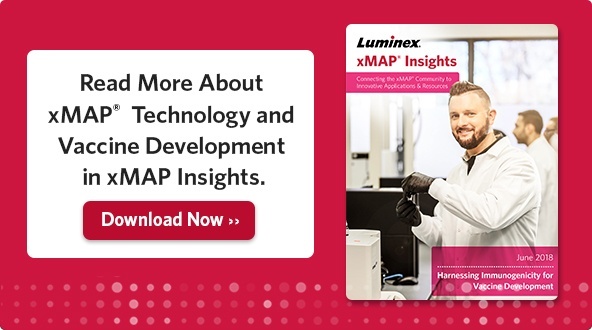Bonus: Pro tips for xMAP® assay developers

Since 1967, the Serum Institute of India has launched more than 20 vaccines, with five more vaccines in the pipeline specifically designed to target infectious diseases that are prevalent in developing countries. Impressively, the institute has produced more than 1.3 billion high-quality, low-cost vaccine doses.
The team there relies on xMAP® Technology for the quality control and characterization of multivalent and combination vaccines. We chatted with Sunil Gairola, PhD, Director of Quality Control, and Manish Gautam, PhD, Senior Manager in the Analytical Development Group, for insights into the development of the next generation of vaccines.
What are the challenges you encounter in quality control for vaccine manufacturing?
Sunil Gairola: Quality control of vaccines is challenging because vaccines are heterogeneous with respect to composition. Also, it’s often difficult to link a certain immunological effect to a specific product characteristic in regards to specific correlates of protection. Lastly, quality control assays aren’t one-size-fits-all, meaning each type of vaccine class requires a specific assay.
Share your thoughts on technologies.
Gairola: In the last decade, the number of analytical techniques used for the characterization of antigens has increased substantially. Techniques can be broadly classified into two categories:
- Techniques used for measuring the concentration and integrity of antigens. This category includes colorimetric and analytical separation techniques used for quantification of intermediate, final products, and detection of impurities.
- Techniques used for measuring the biological activity, active concentration, or confirmation of antigens. This group includes animal tests, cell-based assays, and immunochemical techniques.
The antigen concentration in the final lot is often relatively very low, which hampers the characterization of the final formulated vaccine. Low antigen concentrations are a significant challenge, especially for combination and multivalent vaccines. To cater to such complex requirements, the Serum Institute has a specialized team and infrastructure centralized in the Analytical Development Group.
What does the Analytical Development Group do?
Manish Gautam: The Analytical Development Group develops, validates, and implements analytical technology solutions for quality control and characterization of multivalent and combination vaccines. We currently use xMAP®, capillary zone electrophoresis, HPSEC-MALS, and LC-MS technologies to test for quantity, potency, purity, and identity, as well as detailed structural characterization. We also contribute to detailed immunogenicity assessments of vaccines with respect to the development of newer animal models and assays for characterizing the antigen-specific humoral and cell-mediated immunity responses in animal models. For example, the pneumococcal conjugate vaccine is a multi-serotype vaccine, and quality control testing involves more than 300 tests for release of one batch of vaccine.
How does The Serum Institute use xMAP Technology?
Gautam: Safety and potency assessment of a candidate vaccine is a major stage-gate for vaccine development. In efficacy assessment, assays that measure antibody levels or any aspect of adaptive immune response such as antibody avidity, functional antibody assays, and cellular immune responses (T-cell proliferation and cytokine quantification) are required to understand the correlates of protection in animal models. Multiplexing is an advantageous technology because it enables simultaneous analysis of several antigens from very small sample volumes.
We use xMAP Technology in all phases of research and development, from toxicological studies to the final Phase 3 studies meant for licensure. We find the greatest value for multiplex technology with combination and multivalent vaccines, wherein higher throughput and reduced sample volumes help us to generate real-time data from animal models. In addition to immunogenicity assays, we have also developed xMAP-based assays for routine testing of vaccines, including identity, potency, and dose confirmation-based assessments. We are also working on exploring applications of xMAP Technology in the genotypic characterization of strains used in the vaccines.
What are the specific challenges of coupling polysaccharides?
Gautam: The specific challenge of coupling polysaccharides to the beads is the lack of a harmonized approach towards using a specific kind of conjugation chemistry for coupling. Many methods have been reported in the literature for coupling polysaccharides to the xMAP beads, each with advantages and limitations. While the scientific literature is rich with information on troubleshooting protein-coupling issues, polysaccharide-based applications are limited, so not much work has been reported regarding troubleshooting. An additional issue is the availability of polysaccharides for coupling. We need to define the minimum acceptance criteria for polysaccharides to be used for coupling with respect to size, purity, and stability.
Can you share a few tips for fellow xMAP assay developers?
Gautam: Here are our top tips for multiplex assay development:
- Invest up-front time to select the best assay format for your application.
- Evaluate your assay outcomes with adequate assay controls.
- Establish criteria for cross-reactivity, specificity, and selectivity criteria in advance.
- Choose the best curve-fitting model for optimal assay performance.
- Validate your assay extensively and have a good monitoring plan.
Resources
- Getting Started with xMAP® Technology [Video]
- Browse 1,200+ Partner Kits with xMAP® Kit Finder [Online]
- xMAP® Cookbook to Design Your Own Assays [Download]
- View the latest xMAP® Insights Newsletter [Online & Download]
